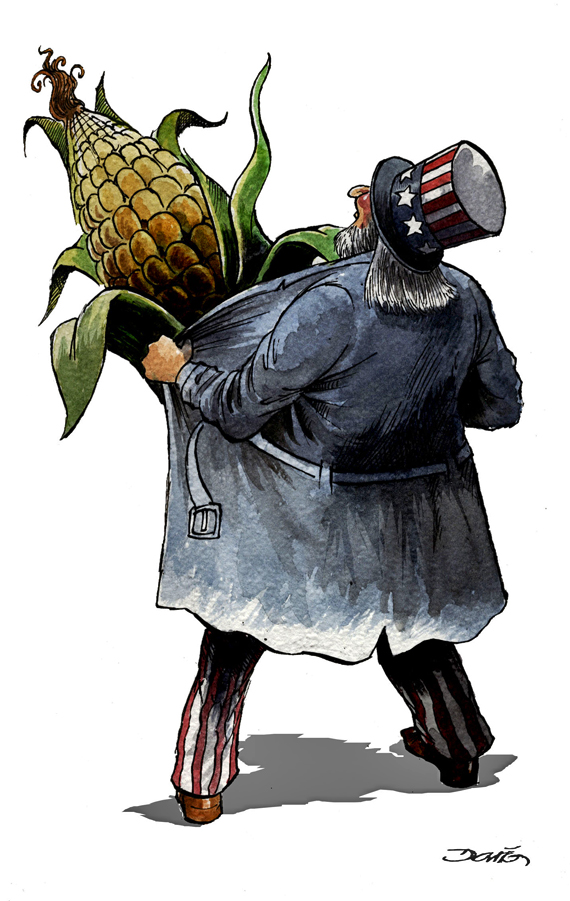|
José Sarukhán, Mexico’s most renowned ecologist
and the current president of the National
Committee on Biodiversity Use and Knowledge (Conabio),
declared his opposition to the planting of GM
corn crops in Mexico because of the risks posed
for indigenous corn.
His statements comes at the same time that
Monsanto
pressures the Mexican government into
authorizing the experimental planting of GM
corn, despite the risk it would have in
areas that are a source of non-GM corn
strains for the world, that is, sites where
corn as we know it originated and which, as
such, constitute very valuable biological
enclaves.
The granting of these planting permits is in
the hands of Environment and Natural
Resource Secretary Juan Elvira Quesada,
who will be making a historical decision.
“Juan Elvira can’t play the fool. He
knows perfectly well the hold that corporate
interests have on various sectors of the
Mexican government. He’s already had to stop
Víctor Manuel Villalobos in one
opportunity, as from his position in the
Agricultural Department he tried to steer
Mexican policy to favor
Monsanto’s
interests, during a meeting of the Cartagena
Protocol, the international treaty that
recognizes a nation’s right to apply the
precautionary principle to prevent imports
of genetically-modified organisms when they
are considered a potential threat to health
or biodiversity,”
Alejandro Calvillo,
director of the consumer defense group El
Poder del Consumidor, said.
|
La introducción del maíz
transgénico no responde más que al
deseo de un par de grandes
corporaciones -especialmente
Monsanto-, de apropiarse de las
semillas del mundo y obligar a los
campesinos a pagar regalías cada vez
que siembren. |
In 2003, Dr. Sarukhán, former president
of UNAM, Mexico’s leading university,
headed one of the most important studies
conducted to assess the impact that introducing
GM corn would have in Mexico. This study
was commissioned by the Environment
Cooperation Committee of the North American Free
Trade Agreement and involved experts from
several nations. The study’s conclusion was a
recommendation to the Mexican government to ban
GM corn imports, because of the potential
environmental, social and economic consequences
of introducing such crops.
“The introduction of GM corn merely responds to
the wishes of a few large corporations -
especially
Monsanto
- to appropriate the seeds of the world and
force campesinos to pay royalties every time
they plant,” Calvillo said.
“Yes,
it’s true,”
Sarukhán
admits. “There
are many economic interests behind this. But
when it comes to food issues, the question is:
do we put the economic interests of one, two or
three companies before the social interests of
the Mexican people? Are private interests more
important than social interests?
I
don’t think so.”
Apart from the environmental and health risks
posed by GMOs, there’s an additional evident
risk: planting GM corn will cause its pollen to
contaminate indigenous corn strains. And once
the gene patented by
Monsanto
makes its way into native corn strains through
cross-pollination, the corporation will be able
to make Mexican farmers pay royalties every time
they plant a seed, even though that seed was
developed over thousands of years by their
ancestors.
|
This has happened already with
rapeseed in
Canada,
where
Monsanto
brought a lawsuit against organic
growers
whose seeds were contaminated by GM
rapeseed
produced by that corporation. It’s
no coincidence
that as it developed its GM crops
Monsanto
harnessed itself with an army of
lawyers to sue
farmers for planting seeds that
contained the
company’s proprietary genes.
According to the Oct. 2, 2009
edition of
La Jornada, at the presentation
of the book Origen
y Diversificación del Maíz, una
revisión analítica
(Origin and Diversification of Corn.
An Analytical
Review), Sarukhán said that
GMOs are neither good
or bad, but rather it depends on how
they’re used.
|
“But corn is different. We can’t think of it as
being the same as soybean. There’s been a great
contribution in terms of genetic improvement (in
Mexico), which makes corn a natural heritage. It
must be protected.” In his opinion, experiments
should be conducted, “but in such a way and
according to such standards and rules as to
ensure that we have the information we want, and
that we avoid risks like the contamination of
native crop areas with GMOs.”
He noted that corn originated from the plant
teocintle and was domesticated by Mexico’s
native inhabitants, and that there is evidence
that it was the women of the different ethnic
groups that were responsible for generating
diversity and passing down knowledge on corn
domestication. He recalled that
Mexico
has at least 60 native strains, and that each of
them has in turn three varieties or more in
texture and color.
The book indicates that there are four possible
centers of corn origin and domestication, namely
Mexico’s central area (the Federal District and
the states of Mexico, Morelos, Puebla, Tlaxcala,
Hidalgo, Querétaro, Guanajuato and Michoacán);
the region of Oaxaca, Chiapas and Guatemala;
western Mexico (Colima, Jalisco, Michoacán,
Guanajuato, Zacatecas, Nayarit and
Aguascalientes); and northern Mexico (Chihuahua
and Durango).
It recommends reinstating the moratorium on GM
maize planting - applied for 11 years – in order
to define the centers of origin, provide
infrastructure for GMO control, determine the
degree of contamination, and introduce
amendments to the Biosafety and Genetically
Modified Organisms Act.
The report also considers that the country must
protect its two million small-scale farmers,
because “they have to be recognized as the
guardians of the native maize germplasm.”

|